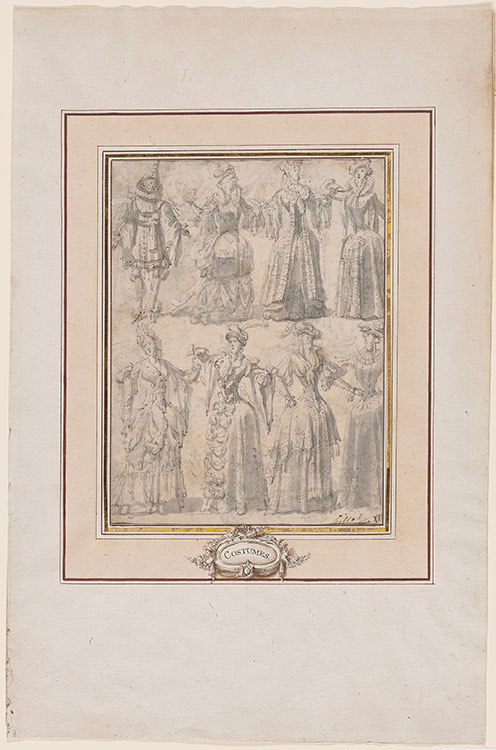

This double-sided sheet, and a second in the Morgan's collection (inv. 2021.4:1), by Claude Gillot are rare examples of his work as a designer of arabesques and costumes. The arabesques (on the verso of both drawings), executed in the artist's preferred combination of black ink and red wash, are on the same scale as the large cache of designs by the artist in Berlin's Kunstbibliothek. The costume designs (on the recto of both sheets), drawn using point of the brush and gray wash, are comparable with Gillot's work in the same technique for a small group of theatrical drawings.
The costume studies of dancers on the rectos of both sheets are rare in Gillot's oeuvre, although examples of such costume sheets with figures in two rows can be found on drawings in the Ecole des beaux-arts, Paris (inv. MA2541), and the Musée des beaux-arts, Dijon (inv. Alb. TH 18 f⁰ 104). The figures' raised arms and trailing sleeves indicate that they were characters singing and dancing. Comparable costumed figures appear on more finished sheets of costume studies from an album that surfaced in 2004. The female costumes are also close to those found in two compositional studies by Gillot, representing a scene that may be set at the Fair at Bezons; one is in the Harvard Art Museums (Inv. No. 1991.240), and the other at the Städel Museum, Frankfurt (inv. No 16349).
The verso of this sheet contains a design for an arabesque with hippocamps in the center, above an oar and trident with mermen below. These nautical motifs were common among Gillot's arabesque designs, which include a number of variations on arabesques with Jupiter. This drawing also contains a striking detail: a head of a man wearing a hat at a jaunty angle. The face has exaggerated pointed ears, long hair, and a long trailing moustache. It is drawn in the same manner as a double-sided sheet of studies in the Kunstbibliothek, Berlin, on which Gillot depicted himself making a wide range of exaggerated facial expressions (inv. 2469/65).
Inscribed in brown ink at lower right, Gillot XII; on verso at top, van...[illegible].
